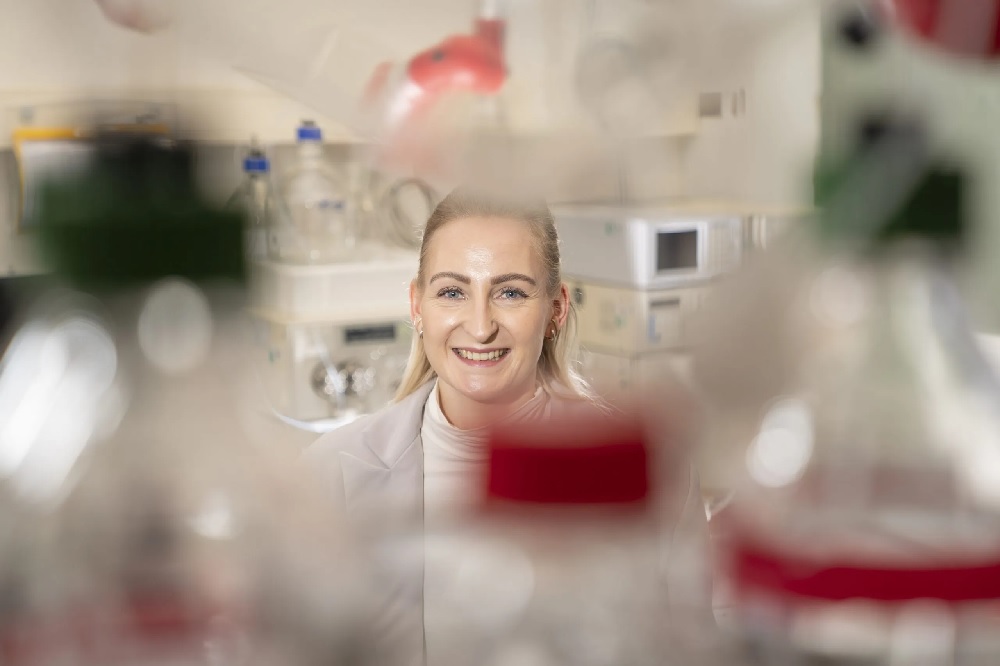Soil bacteria produce proteins and pharmaceuticals from carbon dioxide
A bacterium that can grow on a mixture of carbon dioxide, oxygen, and hydrogen can be persuaded to produce various useful products, such as amino acids, milk proteins, and building blocks for pharmaceuticals. Sandy Schmidt, a biochemist at the University of Groningen, wants to grow this bacterium in a bioreactor that is fed waste gases from factories, to turn carbon dioxide into valuable molecules.
The bacterium Cupriavidus necator was originally isolated from soil near the German town of Göttingen and was, so far, famous for its ability to produce bioplastics. Sandy Schmidt, an Assistant Professor at the Groningen Research Institute of Pharmacy (University of Groningen, the Netherlands) wants to use this microorganism in a different way. ‘It usually grows on sugar, but it can be fed a mixture of carbon dioxide, oxygen, and hydrogen gases,’ explains Schmidt. ‘My idea is to grow it on waste gases from the chemical industry or steel works and to make it produce various useful molecules.’

Cheese
By tweaking the bacterium’s metabolic pathways, it is possible to overproduce, for example, the amino acid lysine, an important component of animal feed. ‘And we are conducting research for a company that wants to make vegan cheese,’ says Schmidt. ‘For this, our bacterium must make milk proteins.’ She has already achieved some milk protein production; however, new genetic tools are needed for the lysine project. ‘Cupriavidus necator is not widely used in science and, therefore, very few tools to adapt its genome have been developed.’
Schmidt has been working on these projects for about two years and expects some tangible results in the next two to three years. ‘By then, we should have strains that produce large quantities of the required products. However, the next step—upscaling the bioreactors to industrial size—might take another five years.’ Apart from the upscaling, the gas mixture she wants to feed the bacteria contains oxygen and hydrogen–a very explosive combination. ‘Solutions to do this safely are being investigated at the moment’
Waste gases
If all goes well, bioreactors could be placed next to steel works or chemical plants, such as Tata Steel or BASF. Schmidt: ‘The waste gases of these factories may also contain sulphur or heavy metals, but our bacterium is fairly resistant against such pollutants, so we don’t have to purify the gases very much.’ One downside to her superbug is that it smells horrible. ‘Students who first get to work with it are really put off by that smell.’

Pharmaceuticals
Despite these drawbacks, Cupriavidus necator appears to have the potential to be a goose with golden eggs. Apart from amino acids and proteins, it can produce building blocks for pharmaceuticals. It is also used to make compounds that are labelled with the carbon-13 isotope, which can be used in medical diagnostics and magnetic resonance studies.
Schmidt is keeping an eye on FutureCarbonNL (a collaboration of Dutch universities, including the University of Groningen, knowledge institutes, chemical and other industries, SMEs, and start-ups), which has submitted a multi-million Euro proposal to the Dutch Nationaal Groeifonds, money that is to be used for investment in carbon capture research. With this proposal is funded, she might be able get extra funding for her work to produce cheese and drugs from factories’ waste gases.
| Last modified: | 27 March 2025 11.46 a.m. |
More news
-
07 April 2025
Plastic recycling: how to best reuse carbon atoms
Scientists at the University of Groningen are working on new ways to recycle plastic waste into new, high-quality products.
-
07 April 2025
Gratama Jubilee gift for Marleen Kamperman and Marijke Leliveld
Prof. Marleen Kamperman and Marijke Leliveld received EUR 100,000 from the Gratama Foundation for their research project aimed at producing organic textiles for sustainable fashion.
-
03 April 2025
IMChip and MimeCure in top 10 of the national Academic Startup Competition
Prof. Tamalika Banerjee’s startup IMChip and Prof. Erik Frijlink and Dr. Luke van der Koog’s startup MimeCure have made it into the top 10 of the national Academic Startup Competition.

